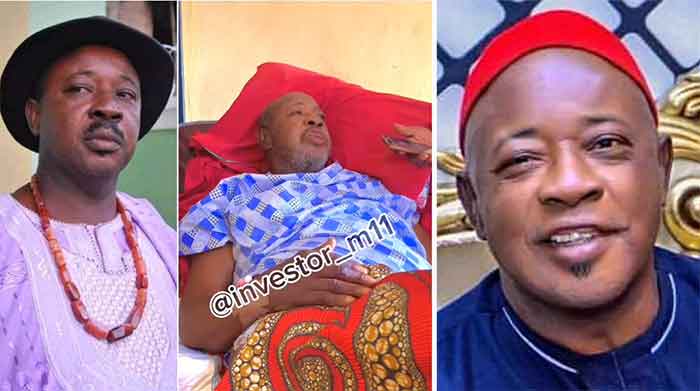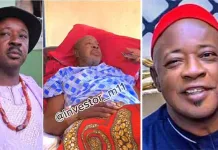Nigerians were startled on Friday when they saw one of their favourite Nollywood actors, Amaechi Muonago, in hospital bed. He said he was struck with stroke that resulted in partial paralysis.
This is coming few weeks after John Okafor, also known as Mr. Ibu, showed up in a video saying his leg could be cut off.

In the video of Mr. Muonago which is trending online, he gave little insight into how his journey to the hospital in Nnewi, Anambra State, began.
“My name is Amaechi Muonago.
“I am sick. This thing that is called stroke caught up with me.
“I was lucky I was not driving. From there they rushed me to hospital,” he said, laying on a hospital bed.
According to him, he has spent months in the hospital.
“Right now, I cannot move. I can’t walk on my own. All my half of left side is paralysed. it is a problem to me.
“I am so sorry I did not make it known to the public early. I did not know that it will last this long.”
Come To My Asistance
Furthermore, the actor sought the support of Nigerians, as he battles to regain his motor skills in his lift side.
“I am calling on well-spirited individuals to come on my assistance and see how they can help me,” he continued.
It was a shocking revelation to Nigerians, seeing the 61-year-old sick in bed.
But not very many of them know what partial paralysis is.
The ailment, also known as paresis, is a medical condition where a person experiences a loss of muscle strength in a specific part of their body.
In the case of the actor, his left side is paralysed.
o help you understand what he may be going through right now, here are the causes, symptoms, and various treatment options available for partial paralysis that you should know.
Causes Of Partial Paralysis
Partial paralysis can result from various underlying causes, including:
1. Stroke
Strokes can lead to partial paralysis when there is damage to the brain, affecting specific muscle groups.
The extent of paralysis depends on the location and severity of the stroke.
2. Spinal Cord Injuries
Trauma to the spinal cord, such as from accidents or falls, can cause partial paralysis. The level of the spinal cord injury determines which body parts are affected.
3. Nerve Damage
Also Conditions like peripheral neuropathy or certain infections can damage peripheral nerves, resulting in muscle weakness or paresis.
4. Brain Injuries
Traumatic brain injuries or brain tumours can impact motor function, causing partial paralysis.
5. Neurological Disorders
Also, Conditions like multiple sclerosis or amyotrophic lateral sclerosis (ALS) can lead to partial paralysis due to damage to the nervous system.
6. Autoimmune Disorders
Furthermore, conditions such as Guillain-Barré syndrome, where the immune system attacks the nerves, can cause muscle weakness and paralysis.
Symptoms Of Partial Paralysis
Basically, the symptoms of partial paralysis can vary depending on the cause and location of the condition.
Common symptoms may include:
1. Muscle Weakness
Affected muscles become weaker, making it difficult to perform everyday activities.
2. Numbness
A lack of sensation or tingling in the affected area may be present.
3. Difficulty Moving
Also, people with partial paralysis may struggle to move specific body parts, leading to impaired mobility.
According to the Nigerian actor, he could not move his left arm and leg effectively.
4. Loss of Coordination
Coordinated movements may be challenging, affecting tasks like walking or holding objects.
5. Muscle Atrophy
Prolonged paresis can lead to muscle atrophy or the shrinking of affected muscles.
6. Pain
Some individuals experience pain in the affected area due to muscle imbalances or strain.
Treatments For Partial Paralysis
The treatment of partial paralysis is determined by its underlying cause, severity, and location.
Advancement in medicine has given birth to reliable treatment possibilities.
In fact, neurotechnology has made major advances in development of interfaces to the nervous system that restore function in paralytic disorders.
Here are some common approaches:
1. Physical Therapy
Physical therapy is a fundamental treatment to help individuals regain muscle strength, improve mobility, and relearn motor skills.
2. Occupational Therapy
Occupational therapists work with individuals to adapt to their daily routines and activities to accommodate partial paralysis.
3. Medications
In some cases, medications may be prescribed to manage pain, inflammation, or underlying conditions contributing to paralysis.
4. Surgery
Also, surgical interventions may be necessary to address specific causes, such as spinal cord compression or nerve entrapment.
5. Assistive Devices
Another treatment is the use of assistive devices like mobility aids. – wheelchairs, braces, or orthotic devices. Indeed, they can enhance independence.
6. Electrotherapy
Furthermore, techniques like electrical stimulation or neuromuscular re-education may be employed to stimulate muscle activity.
6. Speech Therapy
Fortunately, the Nollywood actor’s partial paralysis appears not to have affected his facial muscle.
In cases where partial paralysis affects facial muscles or vocal cords, speech therapy can be beneficial.
But Amaechi Muonago could speak fine.
Most importantly, it is good to note that treatment outcomes vary depending on the individual and the cause of partial paralysis.
Early intervention and a comprehensive treatment plan can significantly improve the quality of life for those living with this condition.
People Also Read: John Okafor: I’m Ashamed Of Nollywood – VeryDarkMan
In conclusion, partial paralysis is a challenging condition that can result from various causes, leading to muscle weakness and other related symptoms.
However, with the right treatment and support, individuals can manage their condition and work towards improved functionality and independence.
We wish the actor well and pray he would recover as soon as possible.
However, if you or someone you know is experiencing symptoms of partial paralysis, it’s essential to consult with a healthcare professional.
It is necessary to ensure the individual gets a proper diagnosis and personalised treatment plan.
Also, if you are woman, you should watch the video below and see how much help Nigerian government is giving to women with Cervical Cancer,

